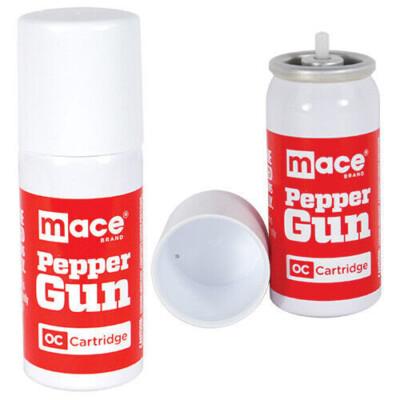Table of Contents
- Understanding the Mechanics Behind Pepper Spray Canisters and Their Refillability
- Materials and Design Considerations Impacting Refill Options
- Evaluating Safety and Legal Implications of Refilling Pepper Spray Canisters
- Expert Recommendations for Maintaining and Choosing Refillable Pepper Spray Devices
- Final Thoughts
Understanding the Mechanics Behind Pepper Spray Canisters and Their Refillability
At the core of every pepper spray canister is a finely engineered mechanism designed to deliver a precise, pressurized burst of irritant fluid upon activation. Most canisters use a spring-loaded valve combined with a small propellant charge which ensures consistent spray patterns and effective dispersal. This mechanism is often encased in a durable metal or plastic body, optimized for portability and ease of use. However, this intricate design also means many pepper sprays are manufactured as single-use devices, with their internal pressure systems sealed permanently to maintain potency and safety standards.
When it comes to refilling options, the scenario varies between brands and models. Some specialty canisters are built with refillability in mind, featuring detachable tops or screw mechanisms that allow users to replenish the fluid-though these are less common and typically marketed towards organizations rather than individual consumers. The downsides of refilling classic designs include:
- Potential loss of pressure consistency, leading to subpar spray performance.
- Risk of contamination or clogging if improper fluids or non-sterile solutions are used.
- Voiding manufacturer warranties and potential legal restrictions depending on jurisdiction.
Materials and Design Considerations Impacting Refill Options
The design and materials used in producing pepper spray canisters play a crucial role in determining whether refills are feasible. Most canisters are made from lightweight metals like aluminum or durable plastics, engineered for portability and easy handling. However, these materials often come with stringent sealing mechanisms to prevent leaks and maintain pressure. This leads to a sealed, single-use design, minimizing the possibility of safely reopening or refilling the canister without compromising its integrity or performance. Additionally, the presence of proprietary nozzle assemblies-often integrated with the container body-further restricts refilling as they are tailored for specific formulations and pressures.
When considering refill options, one must also account for safety and regulatory standards that govern self-defense sprays. Many manufacturers prioritize consumer safety by discouraging refills to avoid mishandling or contamination, which could result in inconsistent spray patterns or weakened active ingredients. If refills are available, they typically come through brand-specific kits that include compatible canisters and approved spray solutions. Key design considerations that impact these options include:
- Pressure containment: Canisters must withstand high internal pressures to effectively disperse the spray.
- Nozzle compatibility: Ensures a consistent and reliable spray pattern, which may not transfer between different canisters or brands.
- Material integrity: Prevents corrosion or degradation that could result from refilling with unapproved substances.
Evaluating Safety and Legal Implications of Refilling Pepper Spray Canisters
When considering refilling pepper spray canisters, safety must be the foremost priority. Improper refilling procedures can lead to malfunctioning devices, leakage, or accidental discharge, all of which pose significant risks to the user and those nearby. Additionally, the chemicals inside pepper spray are potent irritants, and mishandling during the refill process can cause unintended exposure, skin burns, or respiratory distress. It’s crucial to use proper equipment designed specifically for refilling and to follow manufacturer guidelines meticulously to avoid compromising the device’s reliability and safety.
Beyond safety concerns, the legal landscape governing the refilling and resale of pepper spray canisters varies widely depending on jurisdiction. Some regions impose strict regulations or outright prohibit refilling to prevent misuse or distribution of altered canisters that may not meet safety standards. Users should be aware of local laws which might include:
- Restrictions on the types of chemicals allowed in refills
- Licensing requirements for handling or distributing pepper spray products
- Penalties associated with unauthorized modifications or refilling
Expert Recommendations for Maintaining and Choosing Refillable Pepper Spray Devices
When selecting a refillable pepper spray device, professionals recommend prioritizing durability and ease of refilling. Opt for models constructed from high-grade materials such as anodized aluminum or reinforced polymer, which resist wear and provide a reliable grip under pressure. Additionally, verify that the refill canisters are readily accessible and compatible with the device to avoid frustration during emergencies. Consider devices featuring clear or translucent reservoirs, enabling quick visual inspection of remaining spray volume, which is crucial for timely refills and maintenance.
Maintaining these devices properly is equally vital to ensure they function flawlessly when needed. Experts suggest the following best practices:
- Regular Testing: Conduct short trigger presses away from people and pets every few months to confirm that the spray mechanism is operational.
- Clean Storage: Keep the canister in a cool, dry place, avoiding exposure to extreme temperatures that can degrade the formula or damage the unit.
- Refill Protocol: Always use manufacturer-approved refills and follow the instructions precisely when replacing the spray, ensuring no leaks or blockages occur.
- Inspection: Routinely check seals and nozzles for cracks or clogs, replacing any compromised parts promptly to maintain optimal performance.
Final Thoughts
In conclusion, while the idea of refilling pepper spray canisters might seem convenient and cost-effective, it’s important to understand the limitations and safety considerations involved. Most commercial pepper sprays are designed as single-use units without official refill options, primarily to ensure the efficacy and reliability of the product when you need it most. However, if refillability is a key concern for you, exploring specific brands or models that offer refill canisters might be worth considering. Always prioritize buying from reputable manufacturers and ensure you comply with local regulations regarding pepper spray use and refills. Staying informed and prepared is the best way to ensure your personal safety without compromising on quality or legality.Check Our Other Blogs
- StunGun – Your Trusted Source for Stun Guns, Laws, and Self-Defense Tips
- PepperSprayLaws – Your Trusted Resource for Pepper Spray Information
- StunGunLaws – Your Trusted Guide to Stun Gun Legality and Safety




